Understanding Decreased Eye Pressure: Causes and Effects
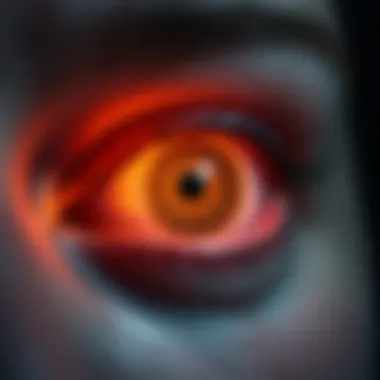
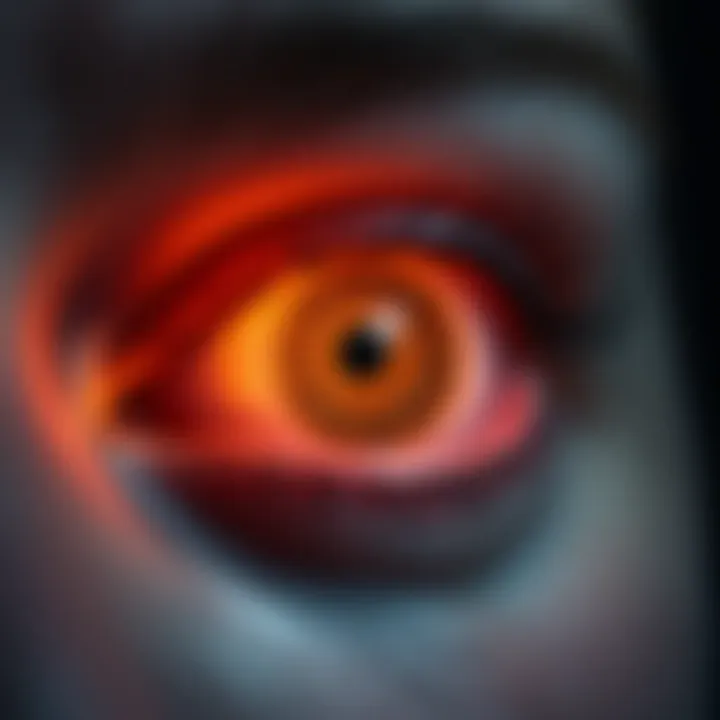
Intro
Decreased eye pressure, while often considered a rarity in ocular health discussions, is a topic that warrants more attention than it typically receives. Unlike its often more familiar counterpart, glaucoma, characterized by elevated intraocular pressure, low eye pressure brings with it a host of unique implications for both individuals and the medical community. This exploration of decreased eye pressure reveals not only its causes and clinical significance but also the potential benefits and challenges that accompany a state of lower than normal intraocular pressure.
In recent years, awareness surrounding decreased eye pressure has increased, largely driven by advancements in medical research and technology. This phenomenon can occur both naturally and as a result of various medical interventions, making understanding it vital for healthcare professionals and patients alike. By examining both the physiological mechanisms at play as well as the outcomes that can arise from decreased intraocular pressure, this article aims to provide a thorough overview that informs and educates.
As we venture into this fascinating topic, we'll look at the underlying causes of low eye pressure, the way it can be assessed, and strategies for managing any risks associated with it. Whether it stems from certain medications, surgical interventions, or specific health conditions, the effects of decreased eye pressure reveal much about the complexities of ocular physiology. Moreover, it's essential for those in the field to stay updated as ongoing research continues to generate new insights.
The goal of this article is not just to share knowledge but also to promote a deeper understanding of ocular health and its multifaceted nature. By exploring decreased eye pressure, we aim to equip readers—be they students, researchers, or health professionals—with critical information that can aid in both clinical decision-making and patient education.
Understanding Eye Pressure
Understanding eye pressure is crucial, not just for those with existing ocular conditions, but for anyone interested in maintaining overall eye health. Eye pressure, or intraocular pressure (IOP), is a fundamental aspect of ophthalmology, providing insights into potential ailments and signaling the health of the eye's internal environment. It influences vision, contributes to the appearance of glaucoma, and reflects broader systemic health scenarios. Knowledge about eye pressure lays the groundwork for clinicians and laypersons alike to make more informed decisions concerning their eye care.
By grasping the principles of eye pressure, one gains clarity on when to seek professional evaluation. It also spurs individual responsibility in maintaining optimal ocular pressure through lifestyle choices, awareness of symptoms, and adherence to prescribed treatments, where necessary.
Definition and Measurement
Intraocular pressure refers to the fluid pressure within the anterior chamber of the eye. Specifically, it stems from the balance between the production and drainage of aqueous humor—a clear fluid that nourishes the eye and maintains its shape. The unit of measurement is usually millimeters of mercury (mmHg). Through tonometry, a common ophthalmic examination, practitioners can assess this pressure effectively. Various tonometry methods exist: Goldmann applanation tonometry is widely regarded as the gold standard, while non-contact tonometers are often favored in preliminary screenings due to their ease of use.
The accuracy of eye pressure measurement is vital; changes in IOP can indicate significant health issues, ranging from glaucoma to other ocular conditions.
This measurement is essential not only for diagnosing conditions but also for monitoring disease progression and treatment efficacy. Assessing a patient's IOP can help tailor interventions that will ultimately affect visual health. Hence, staying on top of eye pressure evaluations becomes a cornerstone of preventive eye care.
Normal Ranges and Variability
Normal intraocular pressure typically ranges between 10 and 21 mmHg, a baseline that can vary due to factors such as age, time of day, and even individual physiology. For instance, some individuals may experience diurnal fluctuations, where their eye pressure peaks or dips at specific times, influenced by activities, stress levels, or sleep quality.
However, it’s essential to recognize that what constitutes a “normal” range is not set in stone. Some patients may have a higher tolerance for certain pressures or may be at diabetes or hypertension risks, making it essential to take a comprehensive view of the patient’s overall health picture.
- Factors contributing to variability may include:
- Age: Younger adults might show different responses compared to older populations.
- Time of Day: IOP can fluctuate throughout the day, often peaking in the morning.
- Atmospheric Pressure: Changes in weather could also have an impact.
Understanding these variabilities is imperative for eye care professionals. It helps in crafting a more tailored approach to monitoring and treating eye pressure-related issues, maximizing patient outcomes, and paving the way for future ocular health initiatives.
Physiology of Eye Pressure
Understanding the physiology behind eye pressure is critical when discussing decreased eye pressure. Not only does it provide insights into how the eye functions, but it also has vast implications for both eye health and vision quality. Eye pressure, often reflected as intraocular pressure (IOP), plays a pivotal role in maintaining the shape of the eyeball and ensuring that the internal structures are appropriately nourished. When this pressure is too low, it can lead to complications that may affect visual integrity.
Anterior Chamber Dynamics
The anterior chamber of the eye is a fluid-filled space located between the cornea and the iris. Virtually like a well-oiled machine, this chamber depends on a delicate balance of fluid production and drainage to maintain healthy eye pressure. It houses the aqueous humor, a clear fluid that is continuously produced by the ciliary body behind the iris. When the production and drainage of this fluid are in sync, intraocular pressure remains within a normal range.
Several factors come into play in this dynamic system. For instance, if the outflow pathways become obstructed, the pressure can rise, whereas increased drainage can lead to hypotony, or low eye pressure. In clinical settings, understanding the mechanics of the anterior chamber can help clinicians diagnose conditions such as angle-closure glaucoma and other related disorders.
Important Considerations:
- Fluid Regulation: It's vital to understand how any alterations in fluid regulation can lead to changes in eye pressure.
- Normal vs. Low Pressure: Clinicians need to differentiate between the malfunctions that lead to high and low pressures as they can present differently in patients.
Aqueous Humor Production and Drainage
Aqueous humor serves not merely as a lubricant but plays multifaceted roles in supporting metabolic needs of the eye tissue. The key here lies in its production and drainage mechanisms which, when disrupted, can create scenarios of decreased eye pressure.
The ciliary body, through specialized cells, continuously produces aqueous humor. This fluid then flows through the pupil into the anterior chamber and ultimately drains through the trabecular meshwork and Schlemm’s canal. If the pathways for drainage become overly efficient due to certain physiological changes or external factors, this may lead to a dip in intraocular pressure.
However, not all methods affecting drainage are natural. The introduction of certain medications can also impact the dynamics of aqueous humor, often aiming for therapeutic effects in conditions characterized by high eye pressure but occasionally resulting in unintended low-pressure situations.
Key Factors:
- Production Signs: Increased production often relates to eye strain or inflammation.
- Drainage Pathways: A well-functioning drainage system prevents excess buildup, which could skew pressure low or high.
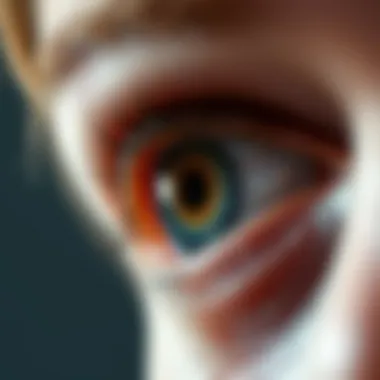
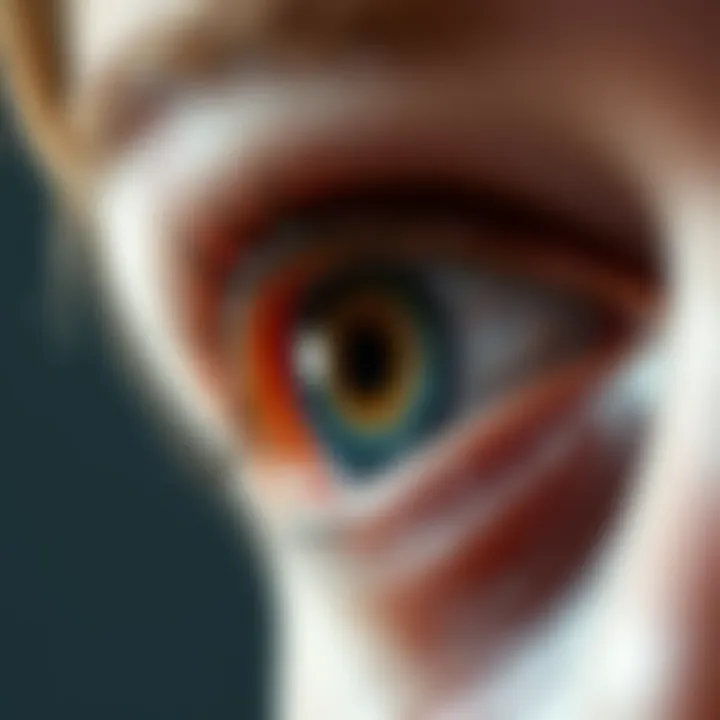
Causes of Decreased Eye Pressure
Understanding the causes of decreased eye pressure is pivotal in comprehending its potential implications for vision and overall ocular health. Various physiological and pathological factors can lead to a drop in intraocular pressure (IOP). Knowing these causes can arm healthcare professionals and patients alike with foresight needed for effective management or intervention. Taking a closer look at these underlying aspects can significantly enhance one’s understanding of the condition, leading to better outcomes.
Physiological Sources of Reduction
A decrease in eye pressure can occur naturally under certain physiological processes. For instance, it's common for eye pressure to fluctuate throughout the day. Healthy individuals may experience variations, with lower values in the morning hours and higher ones later in the day. Factors such as hydration levels, body position, and even fluctuations in systemic blood pressure can contribute to these changes.
Another physiological contributor is aging. As individuals age, their ocular structures change. The trabecular meshwork and ciliary body, involved in aqueous humor drainage and production respectively, can become less efficient. This inefficiency can lead to lower IOP as the delicate balance between production and drainage is disrupted.
Key Points:
- Daily variations in IOP: Natural fluctuations are typical.
- Aging effects on ocular structures: Changes in drainage efficiency.
Pathological Conditions
Decreased eye pressure can also arise from various pathological conditions, some of which require medical attention. One notable condition is ocular hypotony, which occurs when IOP drops below the normal range. This can lead to potential complications. Conditions such as trauma to the eye or surgical procedures can damage the drainage pathways, resulting in a sharp reduction in pressure.
Other disorders, like uveitis and retinal detachment, can impact IOP as inflammatory processes disrupt normal eye function. In these cases, not only is the eye's pressure compromised, but the overall health of the eye and its structures can be at risk.
"Intraocular pressure reduction might seem benign, but its underlying causes can be complex and necessitate careful evaluation."
Impact of Medications
Certain medications can have the side effect of lowering eye pressure. Topical medications used in glaucoma management, such as latanoprost or timolol, while meant to reduce elevated IOP, can paradoxically lead to decreased pressure in some individuals.
Additionally, systemic medications like beta-blockers or some types of antihypertensives can influence ocular pressure. Recognizing the role of medications is crucial as it helps inform both doctors and patients about potential fluctuations in eye pressure, allowing them to respond proactively.
Considerations:
- Anti-glaucoma medications: Can lower pressure unexpectedly.
- Systemic medications: Influence on IOP must be closely monitored.
Understanding the causes of decreased eye pressure is not just an academic exercise; it provides meaningful insights that can deeply impact diagnosis, treatment, and the ongoing management of ocular health.
Clinical Implications of Decreased Eye Pressure
Understanding the clinical implications of decreased eye pressure is crucial for both practitioners and patients. Eye pressure, measured in millimeters of mercury, plays a significant role in maintaining ocular health. While elevated eye pressure often garners attention due to its association with glaucoma and other conditions, decreased eye pressure, or hypotony, brings its own set of challenges and warrants careful consideration.
Hypotony can lead to various consequences, impacting not just the physical aspects of vision but also overall quality of life.
Hypotony: Definition and Consequences
Hypotony is defined as a condition where the intraocular pressure (IOP) falls below what is considered normal, typically defined as less than 10 mmHg. This low pressure can arise from several causes, including surgical complications, trauma, or certain diseases. The repercussions can be direct and immediate, affecting vision clarity and comfort. When the eye pressure dips too low, it can lead to structural changes in the eye, resulting in a condition known as
Diagnosis and Monitoring
Understanding the nature of decreased eye pressure is not just an academic exercise; it’s crucial for maintaining overall ocular health. Diagnosis and monitoring of eye pressure play pivotal roles in identifying potential issues before they lead to more serious complications. This section delves into the methods used for diagnosis and monitoring, emphasizing the significance of these practices in both clinical and research settings.
Ophthalmic Examinations
Ophthalmic examinations serve as the first line of defense in diagnosing decreased eye pressure. These comprehensive evaluations are instrumental in providing a detailed analysis of the ocular structures. During an examination, an eye care professional assesses not only the intraocular pressure but also other key factors that could influence or be influenced by it.
Some of the common components of ophthalmic examinations include:
- Visual acuity tests: Assessing sharpness of vision can reveal any immediate effects of decreased eye pressure on one’s sight.
- Slit-lamp examination: This allows the ophthalmologist to take a closer look at the anterior segment of the eye and check for abnormalities.
- Fundoscopy: Using an ophthalmoscope, the practitioner examines the retina and optic nerve, which helps in determining the overall health of the eye.
Properly conducted examinations can catch subtle signs of hypotony or other pathological conditions earlier, which can lead to timely interventions. In a world where many individuals rely heavily on their vision, understanding these assessments gives patients a crucial proactive role in managing their ocular health.
Use of Tonometry
Tonometry is an essential tool in the realm of eye health, specifically when dealing with eye pressure. This method measures the intraocular pressure (IOP) and serves as a cornerstone of glaucoma diagnosis, although its relevance extends beyond this common eye condition. There are several types of tonometers, with the most notable being the Goldmann applanation tonometer and the non-contact tonometer, which is often referred to as the air puff tonometer.
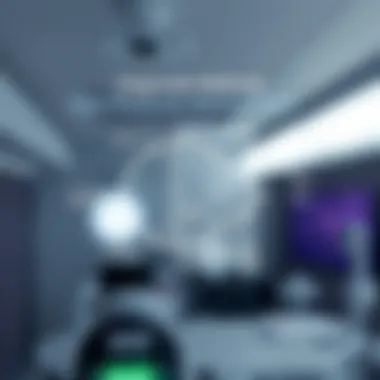
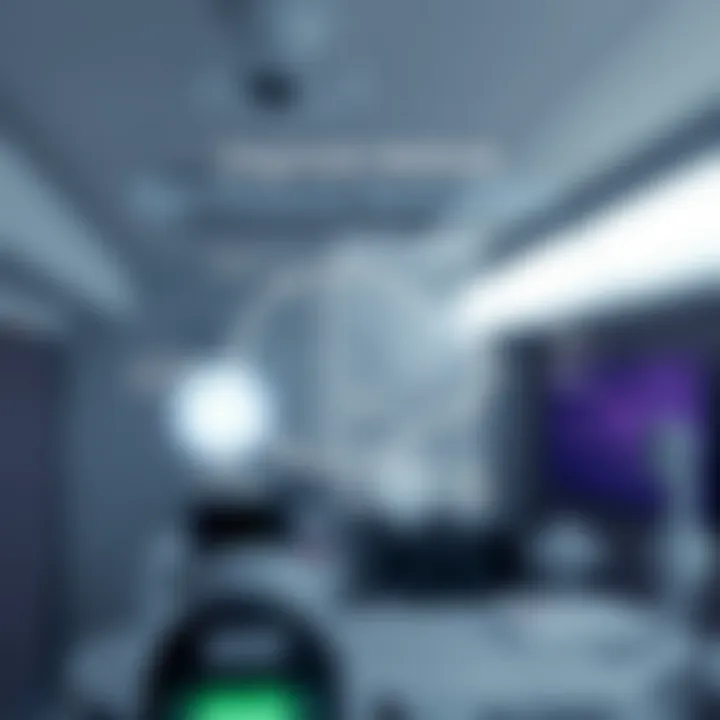
The significance of tonometry lies in its ability to help practitioners identify abnormal pressure levels, which can indicate the potential for ocular complications. Here are some key points regarding the use of tonometry:
- Regular assessments: Frequent tonometric assessments can show fluctuations in eye pressure over time, leading to better management.
- Non-invasive options: Non-contact methods provide a stress-free experience for patients, making it easier to perform routine checks without discomfort.
- Accurate readings: Unlike other tests, tonometers provide quantifiable data on IOP, aiding in targeted management plans.
Management Strategies for Decreased Eye Pressure
Understanding how to manage decreased eye pressure is crucial not only for ocular health but also for overall well-being. This section dives into viable strategies to address low intraocular pressure (IOP), intertwining lifestyle modifications and medical interventions. Recognizing the needs of individuals experiencing this condition can lead to enhanced quality of life and better visual outcomes.
Lifestyle Interventions
Lifestyle changes can play a significant role in managing decreased eye pressure. Simple adjustments daily can lead to noticeable differences in eye health. Here are some key interventions:
- Hydration: Staying well-hydrated can support overall eye health. Aim for adequate water intake but consult your healthcare provider about optimal levels.
- Nutrition: A balanced diet rich in vitamins A, C, and E, as well as zinc and omega-3 fatty acids, may bolster eye function. Foods like carrots, leafy greens, and fish should feature prominently in your meals.
- Exercise Regularly: Moderate exercise has shown to help maintain healthy eye pressure. Activities like walking or cycling can promote better blood circulation, thereby supporting eye health. However, it’s wise to choose low-impact exercises if you're significantly affected by hypotony.
- Manage Stress: High stress levels can negatively impact overall health, including eye pressure. Mindfulness practices such as yoga or meditation might be beneficial. Finding techniques that work for you is key in keeping stress at bay.
"An ounce of prevention is worth a pound of cure." – Benjamin Franklin. In terms of eye pressure, consistently applying lifestyle changes may be the most effective preventive measure.
Implementing these lifestyle adjustments isn’t simply about managing decreased eye pressure; they can enhance your overall wellness. It’s essential to understand that while these measures may help decrease symptoms, they should complement—and not replace—professional medical advice.
Pharmacological Approaches
When lifestyle modifications are insufficient, pharmacological strategies may be required. Medications can provide more immediate results in managing low eye pressure, but it’s vital to approach this under professional guidance. Here are some important considerations:
- Topical Medications: Various solutions (like beta-blockers or carbonic anhydrase inhibitors) can lower IOP. These drops help manage fluctuations and can be adjusted as needed based on individual circumstances.
- Oral Medications: In certain cases, healthcare providers may prescribe oral carbonic anhydrase inhibitors to help decrease aqueous humor production and control IOP.
- Surgical Options: For complex scenarios where medication fails to control eye pressure, surgical interventions may become necessary. Procedures focus on enhancing drainage or decreasing the amount of fluid produced within the eye.
- Regular Monitoring: Any medication regimen should be closely monitored. Side effects can occur, warranting periodic check-ups and potential adjustments in treatment plans.
Ultimately, the choice of pharmacological treatment must be customized to align with the individual's medical history and current health status. Working collaboratively with eye care professionals can yield the best strategies to address this condition effectively.
Research Developments in Eye Pressure Regulation
Understanding the nuances of eye pressure regulation is crucial, particularly in light of emerging therapies and technologies that could redefine our approaches towards ocular health. Research developments in this area are not just academic pursuits; they hold the potential to transform how we address conditions related to decreased eye pressure. By examining the underlying mechanisms and advancements, we can gain insight into how these innovations could benefit both clinicians and patients alike.
Emerging Therapies and Technologies
Recent advancements in the field have manifested in several innovative therapies and technologies aimed at regulating eye pressure effectively. For instance, microneedle technology is being explored as a means to deliver medications directly into the eye without the need for invasive procedures. This method promises to enhance bioavailability while minimizing systemic side effects associated with conventional routes of drug administration.
Another noteworthy mention is the development of smart contact lenses, which are not only designed to correct vision but are also equipped to monitor intraocular pressure in real time. These lenses can alert both the user and healthcare providers about abnormal readings, allowing for timely intervention.
Key Advantages of These Innovations:
- Minimally Invasive Options: Reducing the need for invasive surgical interventions while ensuring effective treatment options.
- Enhanced Patient Compliance: Innovations like smart lenses can improve adherence to treatment regimens due to their user-friendly nature.
- Real-Time Monitoring: Immediate data collection facilitates proactive management of ocular conditions.
Future Directions in Research
The future seems bright as researchers dive into uncharted territories related to eye pressure regulation. A pivotal area under exploration is the role of biomarkers that can predict fluctuations in eye pressure or even identify individuals at risk of hypotony. By utilizing machine learning and big data analytics, scientist are now able to analyze patterns from vast amounts of clinical data, which may lead to personalized treatment strategies.
Additionally, the use of gene therapy holds promise for individuals with congenital or hereditary conditions that affect intraocular pressure. This approach seeks to modify the underlying genetic errors, potentially offering a long-lasting solution rather than continuous management options.
Promising Research Areas:
- Biomarker Identification: Finding reliable indicators that correlate with changes in eye pressure.
- Gene Therapy Applications: Exploring how genetic modifications can provide permanent solutions for eye pressure issues.
- Behavioral Interventions: Researching how lifestyle modifications could be tailored based on individual responses to treatment.
The exploration of these areas may not only enhance our understanding of eye pressure dynamics but could also lead to significant advancements in patient care, ultimately improving quality of life.
In summary, as we venture further into the realm of eye pressure regulation, the convergence of innovative therapies, cutting-edge technologies, and enlightening research promises a more effective and nuanced understanding of ocular health. By continuing to bridge the gap between research and clinical practice, we can work towards more robust treatment options that cater to the unique needs of each patient.
Impacts of Decreased Eye Pressure on Quality of Life
Decreased eye pressure, while often overshadowed by its converse, increased intraocular pressure, holds considerable significance for individuals navigating daily life. Understanding its impacts on quality of life is crucial not only for healthcare providers but also for patients experiencing this condition. Factors including visual functioning and psychological well-being are interwoven in a tapestry of health that reflects how decreased intraocular pressure isn't merely a clinical measurement but a lived experience.
Visual Acuity and Function
Visual acuity can be affected by abnormal eye pressure levels. Typically, a lowered eye pressure might suggest a decrease in the volume of the aqueous humor, which could alter the eye's focus. For some individuals, this may result in improved clarity of vision in certain scenarios, especially those with chronic conditions causing high pressure. However, this isn't a universal truth. For others, diminished eye pressure precipitates distortions — such as blurred or double vision — leading to challenges in tasks requiring precision, like reading or driving.
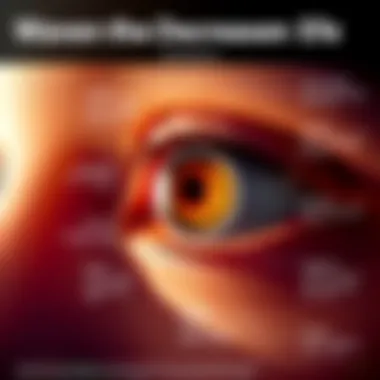
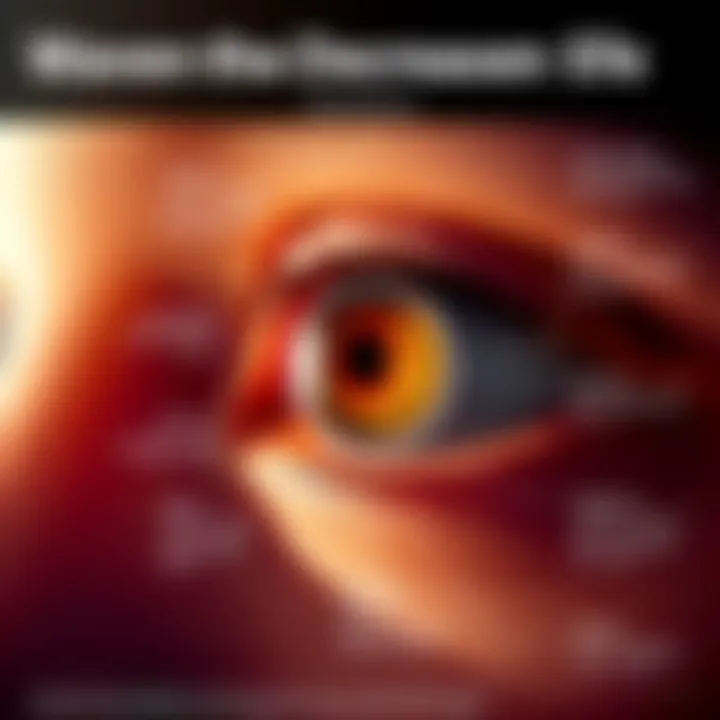
Here are some specific visual impacts:
- Fluctuations in Clarity: Patients may experience varying degrees of visual clarity, which can be unnerving and limiting in practical life.
- Effects on Depth Perception: Eye pressure changes can hinder the brain's ability to judge distances accurately, posing risks in everyday activities.
- Potential for Structural Damage: Chronic hypotony, when eye pressure falls too low, can lead to anatomical changes in the eye, potentially compromising long-term vision.
For those who heavily rely on their sight — professionals, students or even casual readers — adjusting to these changes can be infuriating, leading to a decrease in overall quality of life. Living with compromised vision functionality can trigger concerns that extend far beyond simple inconveniences.
Psychological Considerations
The psychological effects associated with decreased eye pressure are as important as the physical ones. Individuals struggling with visual changes often face a nagging sense of uncertainty or anxiety about their condition. This psychological burden is compounded by fear of potential complications, leading to a cycle of stress and worry.
Some key points include:
- Feelings of Vulnerability: People might feel exposed and vulnerable; incidents of visual impairment can make one feel out of control or isolated.
- Impact on Social Interactions: Changes in vision can lead to withdrawal from social settings, impacting relationships and support systems.
- Stress and Anxiety: The constant pressure of worrying about one's eye health can heighten stress levels, potentially leading to anxiety disorders or depression.
Additionally, factors like the unpredictability of vision can affect job performance, alter daily routines, and necessitate coping strategies that consume mental bandwidth. Recognizing and addressing these psychological implications is vital for holistic patient care.
"The mind and body are two sides of the same coin. When one's visual world shifts, so too does the mental landscape."
Understanding both the visual and psychological impacts of decreased eye pressure enables healthcare providers to craft well-rounded treatment plans that take lifestyle adjustments and mental health support into account. As research continues to develop in this area, recognizing these multifaceted connections can lead to improved outcomes and enhanced quality of life for those affected.
Connection Between Eye Pressure and Systemic Health
The intricate relationship between eye pressure and systemic health cannot be overstated. Understanding this connection is critical, as fluctuations in intraocular pressure can provide insights into broader health issues. Many people think about eye pressure in isolation, yet changes in this localized parameter can serve as indicators of systemic conditions like cardiovascular and metabolic disorders. This section will explore those correlations, emphasizing key elements and considerations to enhance awareness and understanding of the implications of eye pressure beyond ocular health.
Correlation with Cardiovascular Health
Recent studies have explored the link between eye pressure and cardiovascular health, uncovering connections that are quite illuminating. Elevated eye pressure has been associated with an increased risk of cardiovascular diseases, suggesting that what happens in the eye could reflect what is happening in the heart. In simple terms, changes in eye pressure may provide signals of blood pressure anomalies or stress within blood vessels.
- Increased Eye Pressure: Higher levels of intraocular pressure (IOP) can indicate underlying issues with blood flow or vascular health.
- Risk Factors: Common risk factors for cardiovascular diseases, such as hypertension, often overlap with conditions linked to increased eye pressure.
- Preventative Insights: Monitoring intraocular pressure might aid in the early detection of potential cardiovascular issues, allowing for timely interventions. Moreover, understanding these correlations can shift how healthcare professionals approach patient assessments.
"The eye is the window to health; it reflects not just what is wrong in sight but also what is going on at a systemic level."
Role of Diabetes in Eye Pressure
Diabetes represents another significant aspect of how systemic health can affect eye pressure. Individuals with diabetes may experience variations in their intraocular pressure due to several factors. This relationship prompts a deeper inquiry into how diabetes management might influence eye health.
- Diabetic Retinopathy: This common complication of diabetes can alter aqueous humor dynamics, thereby impacting eye pressure.
- Insulin Effects: Fluctuations in insulin levels can affect the balance of fluid in the eye, leading to either an increase or decrease in eye pressure.
- Regular Monitoring: For those living with diabetes, regularly measuring eye pressure is essential. It assists not only with eye health but also with the broader management of their condition.
The interplay between diabetes and eye pressure complicates the clinical picture. Patients who are aware of this connection can take proactive steps to monitor and manage their ocular health alongside their overall systemic health.
Understanding these nuances elevates the conversation around eye pressure, demonstrating how ocular conditions can inform comprehensive health strategies. The broader implications of decreased eye pressure highlight how interconnected bodily systems are and the importance of holistic healthcare approaches.
Patient Perspectives on Eye Pressure Management
Understanding how individuals with decreased eye pressure perceive their condition is paramount. This aspect of eye health encompasses not just clinical outcomes, but also real-life implications for the patients. Such perspectives can greatly inform treatment decisions, lifestyle changes, and broader healthcare policies.
When patients step into the world of eye care, their experiences often shape their understanding of their health condition. This is especially true for those dealing with decreased eye pressure, a situation that some may find perplexing. Just like navigating through fog, they may find themselves struggling to see clearly, both in terms of the medical implications and the necessary adjustments in their daily lives. Hence, discussing patient perspectives isn't merely an add-on; it's central to grasping the overall impact of decreased eye pressure.
One critical element is the emotional toll that comes with their experiences. For instance, patients may express feelings ranging from confusion to anxiety regarding their diagnoses. Some might find themselves wading through a sea of information that often contrasts what they had previously known about normal eye health. As conversations in the clinic escalate, these patients might share stories about their fears of losing vision or their apprehensions about potential treatments. Such narratives underline the importance of understanding how these experiences influence adherence to management strategies.
Experiences and Challenges
The experiences of patients dealing with decreased eye pressure can be both enlightening and fraught with challenges. On one hand, some patients report that they feel more aware and engaged in their eye health. This awareness often leads to increased conversations with healthcare providers, driving home the fact that the squeaky wheel gets the oil. On the other hand, navigating through diverse treatment options can prove overwhelming.
Here are some common challenges that arise:
- Confusion about medical jargon: Often, technical language can alienate patients, making it harder for them to grasp their conditions or treatments.
- Emotional stress: The fear of potential vision loss can weigh heavily. Patients regularly report feelings of anxiety, leading them to seek the support of family and support groups.
- Lifestyle changes: Many find themselves needing to adapt daily activities, whether it’s adjusting how they read or the types of screens they use.
"It often feels like my vision changes every day. I have to keep relearning what works for me, adjusting my routine around my eye pressure.” – A patient remark
Stakeholders in Eye Health Management
Understanding patient perspectives involves recognizing various stakeholders within the eye health arena. Each plays an important role in aiding patients along their journey. Here are a few key players:
- Healthcare Providers: Optometrists, ophthalmologists, and primary care doctors are at the forefront of patient education and care. Their role is to not only diagnose but also to empathize with patient fears and hopes.
- Patients: Each individual narrative provides valuable insights, influencing how healthcare providers approach treatment decisions. Their willingness to share experiences can shape future healthcare practices.
- Healthcare Educators: Training future eye care professionals includes teaching them to value and incorporate patient perspectives into their practices.
- Policy Makers: Given the rising prevalence of ocular diseases, there’s a pressing need for policies that reflect the concerns raised by patients. Addressing eye health within broader health policies can lead to more cohesive care plans.
Ultimately, a holistic approach in considering patient perspectives can enhance eye pressure management practices. This not only creates a circle of care that develops mutual understanding but also ensures that clinical treatments remain as responsive as possible to the nuances of patient experiences.
For further exploration of patient-centered care strategies, insights can be found in articles on platforms like PubMed and through conversations on initiatives at reddit.com in communities discussing eye health.







